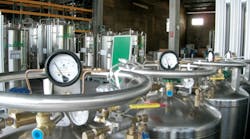A differential-pressure primary flow element to measure gas flow is installed in a horizontal pipe. How should its taps be oriented?
A. On the top of the pipe
B. 45-degrees above the centerline of the pipe
C. On the side of the pipe on the centerline
D. On the bottom of the pipe
Commentary
In gas service, the taps should be oriented so the impulse tubing remains completely filled with gas while ensuring there is no accumulation of liquid between the taps and the transmitter. Failure to maintain a gaseous hydraulic connection between the flow element taps and the differential pressure transmitter can adversely affect the accuracy of the flow measurement system.
Locating the taps on the bottom of the pipe (Answer D) can allow dirt and other solids to enter and potentially plug the impulse tubing, thereby adversely affecting the flow measurement. Liquids in the pipe can also enter the impulse tubing and cause the flow measurement to be inaccurate. In some applications, gas can condense and accumulate in the impulse tubing, likewise causing inaccurate flow measurement.
Locating the taps on the top of the pipe (Answer A) is recommended because liquids that accumulate can drain down into the flow stream, thereby ensuring that the impulse tubing remains full of gas. Answers B and C are also acceptable.
Additional Complicating Factors
Simply locating the taps between the side and top of the pipe (Answers A, B and C) does not ensure that the impulse tubing will be full of liquid. The impulse tubing between the taps and the differential-pressure transmitter should be sloped so as to allow liquids to fall and exit the impulse tubing into the flow stream.
David W. Spitzer is a regular contributor to Flow Control with more than 35 years of experience in specifying, building, installing, startup, troubleshooting and teaching process control instrumentation. Mr. Spitzer has written over 10 books and 150 technical articles about instrumentation and process control, including the popular “Consumer Guide” series that compares flowmeters by supplier. Mr. Spitzer is a principal in Spitzer and Boyes LLC, offering engineering, expert witness, development, marketing, and distribution consulting for manufacturing and automation companies. He can be reached at 845 623-1830.


